Jalisco is a Mexican state located in the central-western portion of the country. The region is characterized by its diverse topography, which ranges from the rugged Sierra Madre Occidental mountain range to the sandy beaches of the Pacific Coast.
This varied landscape provides a perfect habitat for a wide range of bird species, and Jalisco is home to over 500 different types of birds. The state’s extensive bird list includes a range of impressive species from the graceful Harpy Eagle to the vibrant Rosy Thrush-Tanager.
Jalisco’s diverse array of avian inhabitants make it a popular location for both local and international birdwatchers.
1. American Avocet
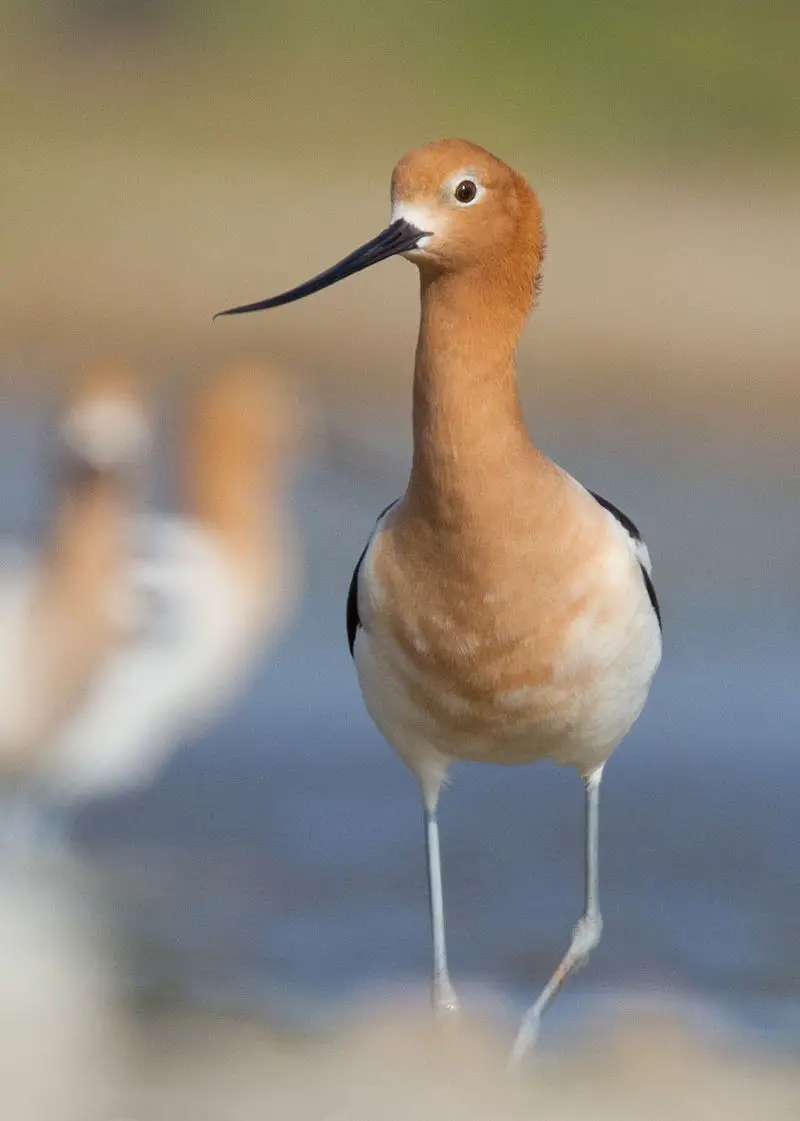
The American avocet is a stunningly beautiful bird found in North America. With its striking black and white plumage, long blue legs, and upturned bill it is an unmistakable sight.
It spends much of its time foraging around shallow water or mud flats searching for crustaceans and insects to feed on by sweeping its beak from side-to-side through the water.
The German naturalist Johann Friedr formally described this species back in 1789 as Recurvirostra americana – aptly named due to their habit of recurving their bills when feeding.
These graceful wading birds are truly a marvel of nature that deserve our admiration.Scientific classification:
| Kingdom | Animalia |
| Phylum | Chordata |
| Class | Aves |
| Order | Charadriiformes |
| Family | Recurvirostridae |
| Genus | Recurvirostra |
| Species | R. americana |
Also Featured In: Most Popular Bird Species in North America, Birds that Live around Central Florida
2. American Coot
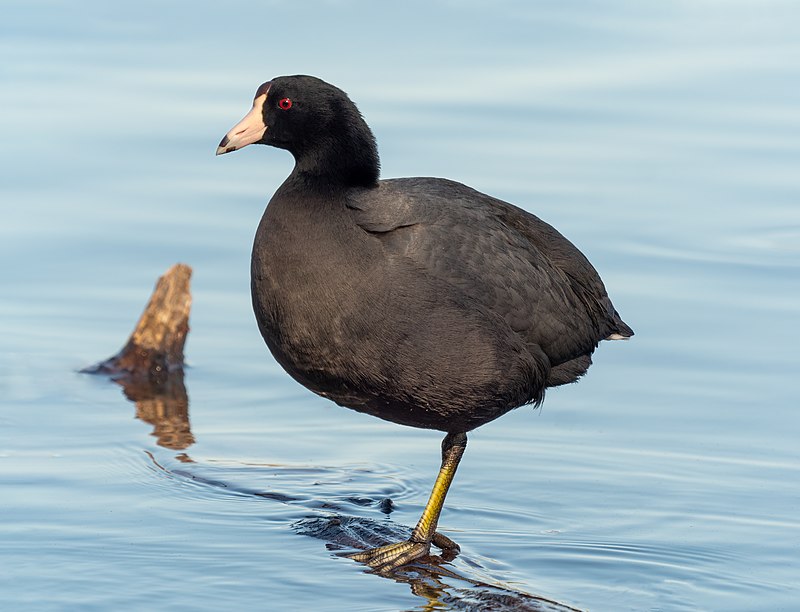
The American coot is a bird of the Rallidae family, commonly mistaken for ducks. However, they are only distantly related and have broad lobed scales on their lower legs and toes that fold back with each step to help them walk on dry land unlike ducks which have webbed feet.
Coots are omnivores who typically live in freshwater marshes, ponds and lakes but can also be found in brackish water habitats or even open oceans during migration season.
They feed mainly on algae and aquatic plants as well as small fish, snails, insects larvae and worms from time to time.
The males display territorial behaviour by chasing away intruders within their territory while females lay eggs mostly.
In floating nests made of vegetation near shorelines or islands among reeds where chicks hatch after about three weeks incubation period before swimming off into adulthood shortly afterwards at 10-12 weeks old.Scientific classification:
| Kingdom | Animalia |
| Phylum | Chordata |
| Class | Aves |
| Order | Gruiformes |
| Family | Rallidae |
| Genus | Fulica |
| Species | F. americana |
Also Featured In: Phoenix Birds You Should Know, Water Birds Live around Us
3. Neotropic Cormorant
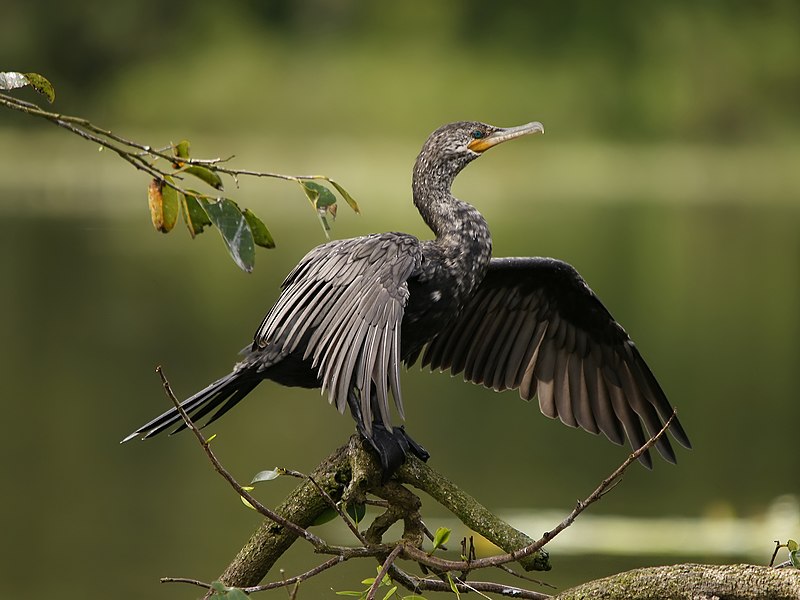
The Neotropic Cormorant, also known as the Olivaceous Cormorant, is a medium-sized bird found in tropical and subtropical regions of Central America, South America and the United States.
It can be identified by its black body with bright yellow facial skin on both sides of its large bill. The tail feathers are short and squared off at the tip.
This species breeds mainly on coasts but will sometimes nest inland near rivers or lakes during certain parts of their life cycle.
They feed mostly on small fish caught while diving underwater but can also eat crustaceans, amphibians and insects.
These birds roost in trees at night to keep safe from predators like foxes which prey upon them when they sleep close to water sources during daylight hours.Scientific classification:
| Kingdom | Animalia |
| Phylum | Chordata |
| Class | Aves |
| Order | Suliformes |
| Family | Phalacrocoracidae |
| Genus | Nannopterum |
| Species | N. brasilianum |
Also Featured In: Beautiful Brazilian Birds, Rainforest Birds You Should Know
4. Black-Necked Stilt
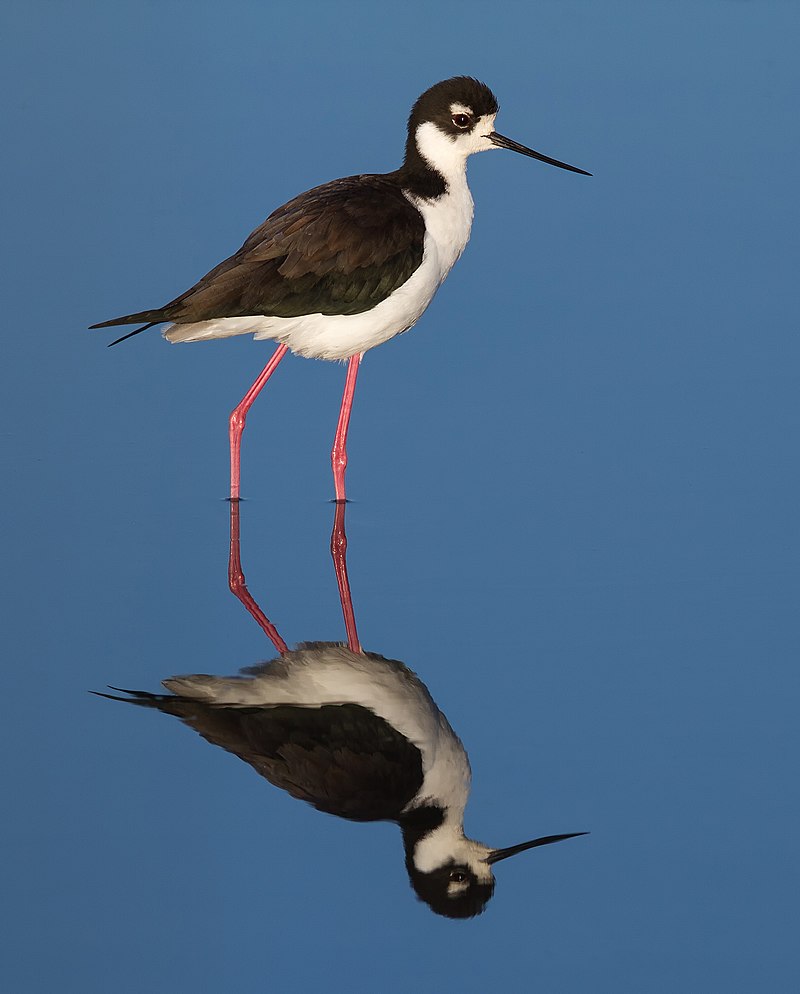
The Black-necked Stilt is an elegant shorebird that can be found from the coastal areas of California to Florida, then south through Central America and Brazil.
It has black upperparts contrasted by long white wings with a glossy sheen. Its striking red eyes are set against its white facial mask while its legs are bright pinkish in coloration.
The Haematopus mexicanus species inhabits marshy wetlands and brackish lagoons where it feeds on insects, crustaceans, small amphibians and fish which they catch using their slender bill or chase after them as they run across the surface of water or mudflats.
This bird typically nests near shallow waters but will use any habitat type if food resources are available nearby making it a highly adaptable species well suited for human altered habitats such as rice fields and sewage ponds.Scientific classification:
| Kingdom | Animalia |
| Phylum | Chordata |
| Class | Aves |
| Order | Charadriiformes |
| Family | Recurvirostridae |
| Genus | Himantopus |
| Species | H. mexicanus |
Also Featured In: Most Common Oahu Birds, Swamps Birds You Should Know
5. White-Winged Dove
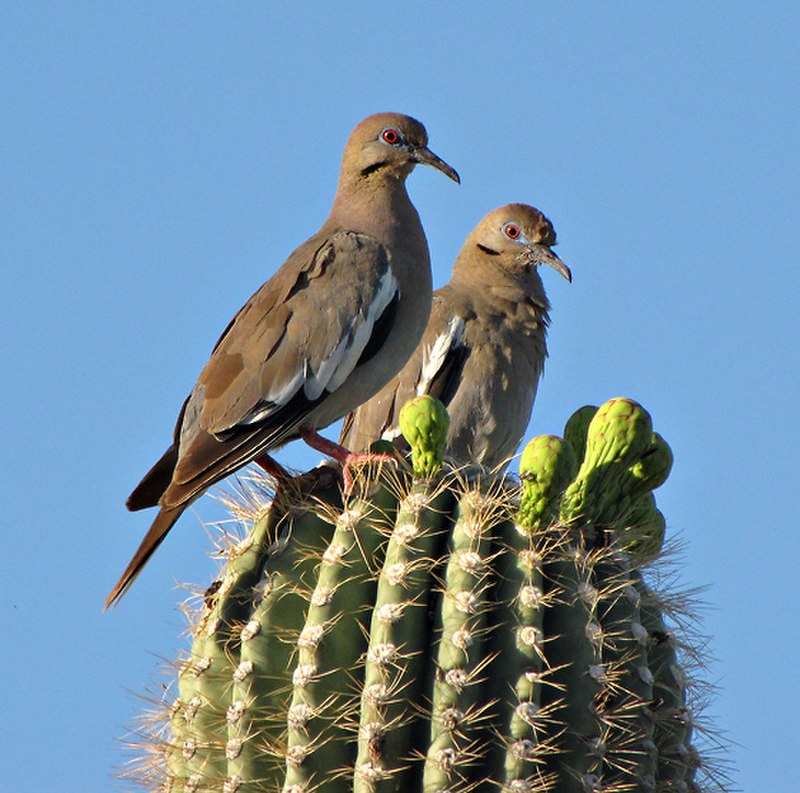
The White-winged Dove is an impressive bird with a large body and wingspan. Its distinctive feature is the white edge on its wings, which makes it easily recognizable when in flight.
It has blue eyerings, red eyes and gray plumage, while juveniles are duller in coloration than adults.
This dove species inhabits areas from Southwestern United States through Mexico to Central America as well as Caribbean islands.
They usually live close to human settlements or cities but can also be found in agricultural fields feeding on grains like corn or wheat seeds left by farmers after harvest season ends.
In their natural habitat they feed primarily on insects, fruits and small plants such as certain cacti species.Scientific classification:
| Kingdom | Animalia |
| Phylum | Chordata |
| Class | Aves |
| Order | Columbiformes |
| Family | Columbidae |
| Genus | Zenaida |
| Species | Z. asiatica |
Also Featured In: Top Birds Found in Mexico, Birds that Live in the Deserts
6. Inca Dove
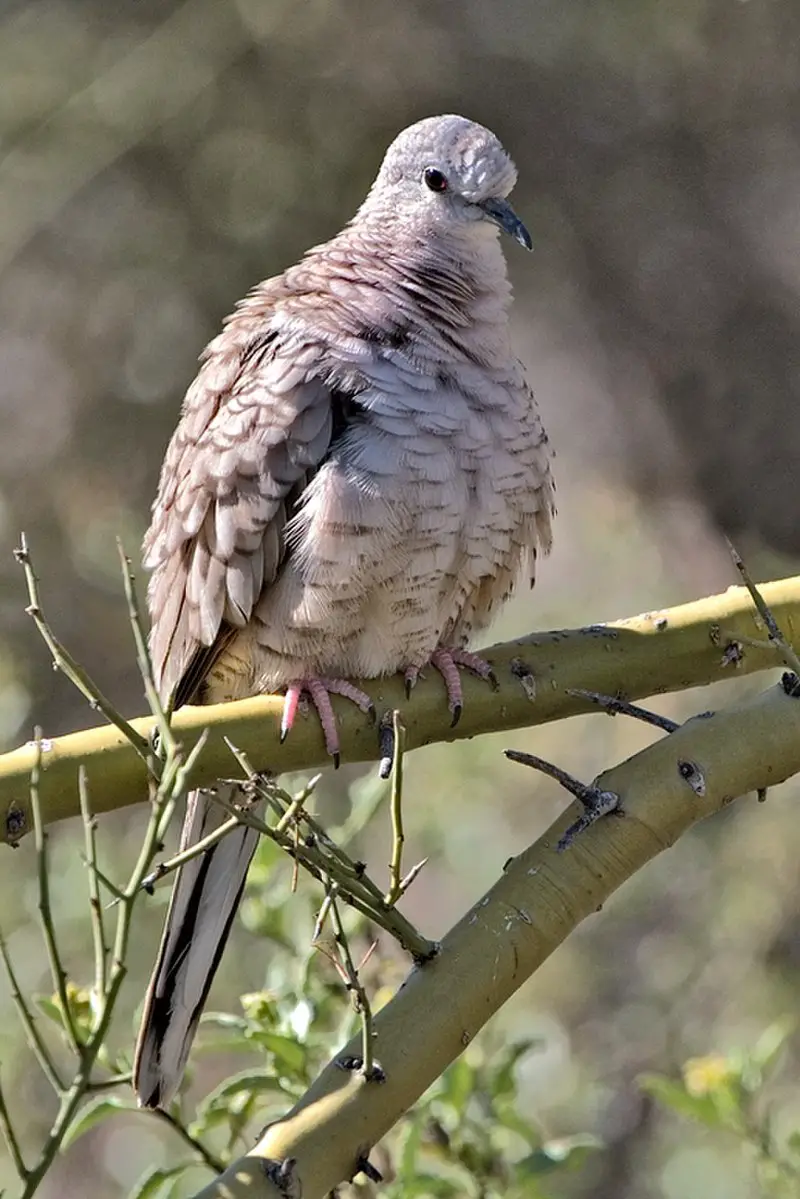
The Inca Dove is a small, slender bird found in the New World. It has an average length of 16.5–23 cm and weighs about 30-58 gm. Its wingspan measures around 28.5cm but can reach up to 32cm at max.
The body of this dove is grayish brown with feathers that are rounded off tips giving it a soft look overall.
This species was first described by French surgeon and naturalist René Lesson back in 1847 and since then have been living happily all over North America from Mexico through Texas to South Dakota, Kansas as well as parts of Arizona among others regions too.Scientific classification:
| Kingdom | Animalia |
| Phylum | Chordata |
| Class | Aves |
| Order | Columbiformes |
| Family | Columbidae |
| Genus | Columbina |
| Species | C. inca |
Also Featured In: Birds You’ll Find in the Rio Grande Valley, Most Common Birds of Nuevo Leon
7. Long-Billed Dowitcher
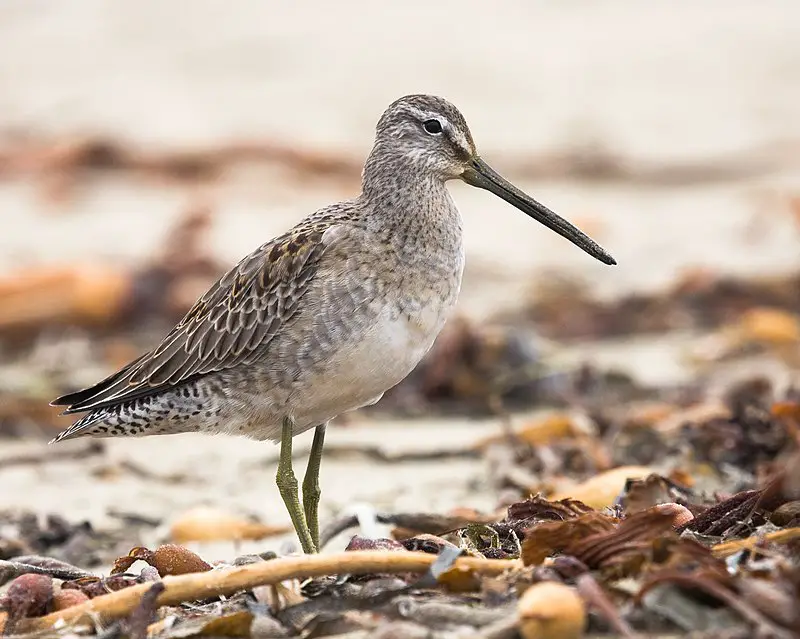
The Long-billed Dowitcher is a beautiful shorebird with an unmistakable long bill. During breeding season, they are characterized by their rufous head and underparts combined with a dark mottled back and large white upper rump only visible when in flight.
These birds can be found in freshwater habitats all over the world, where they forage underwater using their long bills to seek out aquatic invertebrates such as insects or small crustaceans.
They also feed on plant material like seeds and berries during times of scarcity.
The Long-billed Dowitcher is an important species for ecological balance due to its unique feeding habits that help control populations of certain insect pests, which makes it one of the most valuable bird species around us.Scientific classification:
| Kingdom | Animalia |
| Phylum | Chordata |
| Class | Aves |
| Order | Charadriiformes |
| Family | Scolopacidae |
| Genus | Limnodromus |
| Species | L. scolopaceus |
Also Featured In: Birds in Calgary You’ll Love to See, Birds of Norfolk
8. Brown Booby
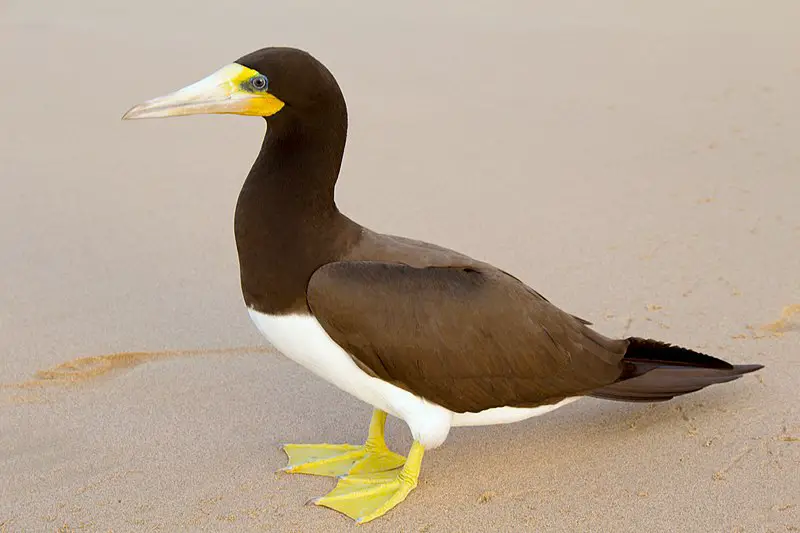
The Brown Booby is a large, seabird from the booby family Sulidae. It has a pantropical range and can be found in many areas of the world.
This bird lives in flocks and forages by plunging into shallow waters to catch small fish that are driven near the surface by predators or storms.
The brown booby is known for its short wings which make it highly maneuverable when hunting; this allows it to pursue prey quickly with sudden turns and dives.
Its diet also includes squid, crustaceans, eggs of other birds, as well as scraps from boats or ships they may come across while flying around coastlines.
They sometimes rest on floating objects during their long flights over open water between islands or continents.Scientific classification:
| Kingdom | Animalia |
| Phylum | Chordata |
| Class | Aves |
| Order | Suliformes |
| Family | Sulidae |
| Genus | Sula |
| Species | S. leucogaster |
Also Featured In: Egyptian Birds, Birds You’ll Find in the Sea
9. Green Kingfisher
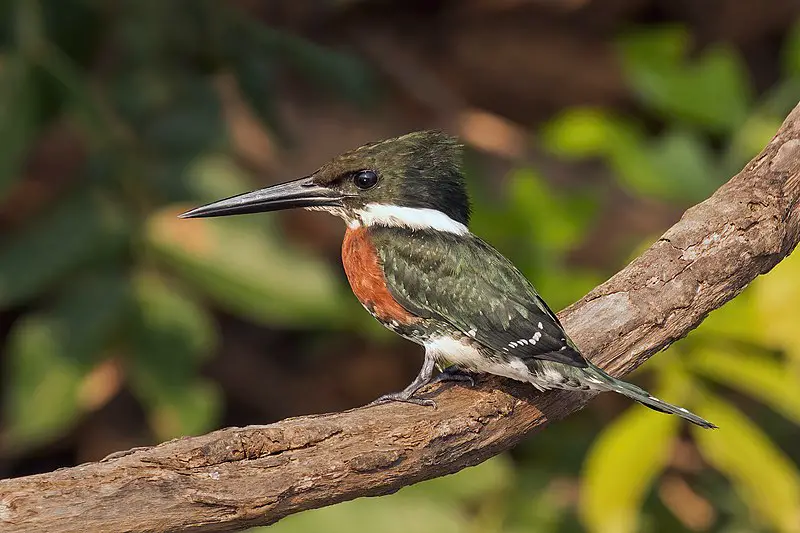
The Green Kingfisher is an incredibly vibrant bird, boasting a bright green plumage and long beak.
It can primarily be found throughout Central America, in most South American countries except Chile, as well as Texas in the United States and Trinidad & Tobago.
This species of water kingfisher belongs to subfamily Cerylinaeof family Alcedinidae which was first described by German naturalist Johann Friedrich Gmeiner back in 1788.
The Green Kingfishers are known for their active hunting habits where they perch above shallow waters looking out for prey such as small fish or crustaceans before diving down rapidly into the water with a loud splash.Scientific classification:
| Kingdom | Animalia |
| Phylum | Chordata |
| Class | Aves |
| Order | Coraciiformes |
| Family | Alcedinidae |
| Subfamily | Cerylinae |
| Genus | Chloroceryle |
| Species | C. americana |
Also Featured In: Most Common Birds Found in Chile, Birds that You’ll Find in Chiapas
10. Lineated Woodpecker
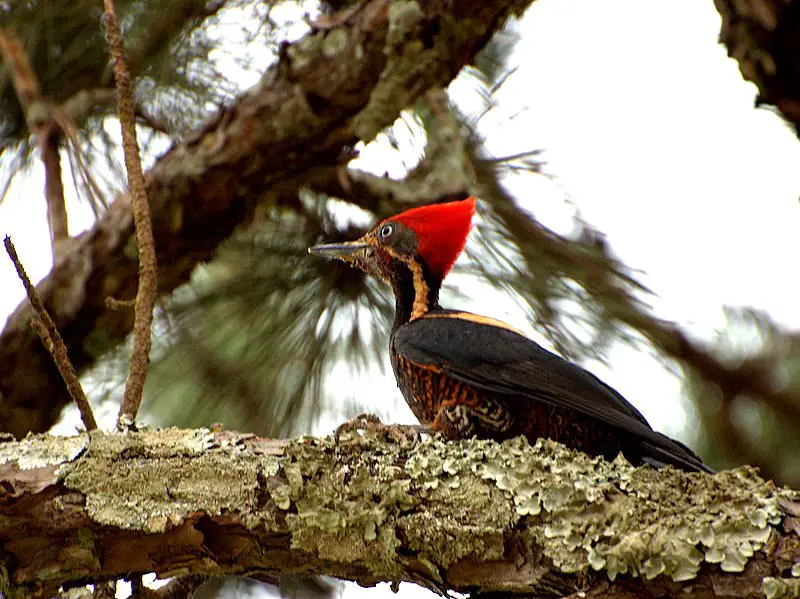
The Lineated Woodpecker is a large bird found in Mexico, Argentina and the Caribbean. It was first described by French zoologist Mathurin Jacques Brisson in 1760 with the name Le pic noir.
This species has black upperparts, wings and tail with white stripes running along its back and head; it also features red marks on its forehead as well as on both sides of its neck.
Its underparts are mostly greyish-white while its bill is yellowish-black and slightly hooked at the end.
These birds feed mainly on insects but can sometimes be seen foraging for fruits or tree sap too.
They nest inside cavities usually made from dead trees which they excavate themselves using their strong bills perfect for drilling into woody material easily.
All in all, these beautiful birds make an interesting addition to any backyard garden.Scientific classification:
| Kingdom | Animalia |
| Phylum | Chordata |
| Class | Aves |
| Order | Piciformes |
| Family | Picidae |
| Genus | Dryocopus |
| Species | D. lineatus |
Also Featured In: Birds of Bolivia, Birds that Live in Guyana
11. Northern Jacana
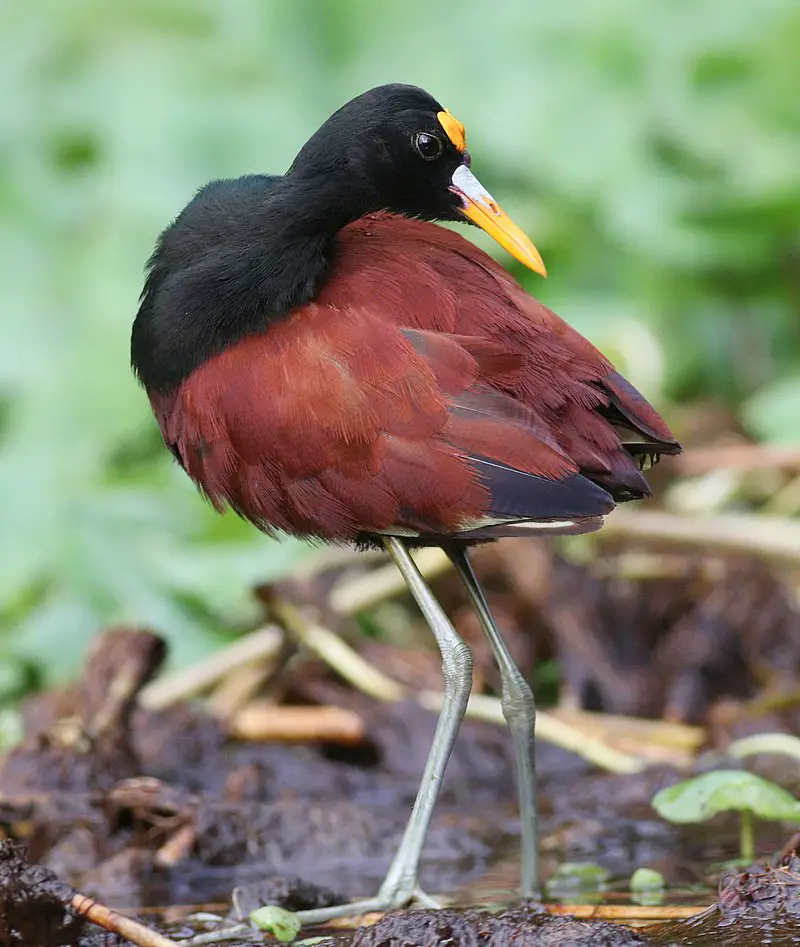
The Northern Jacana is a wading bird native to Mexico, Panama, Cuba, Jamaica and Hispaniola. It can also be found in Texas as a resident breeder or on rare occasions in Arizona as a vagrant.
This species of wetland birds are easily identified by their immense size and large feet with long toes that help them walk atop floating vegetation while searching for food.
Their upperparts have black feathers streaked with white whilst its underparts display brown plumage marked by yellowish spots near the wingtips.
They feed primarily on insects but will also eat other aquatic invertebrates like crustaceans or mollusks when available.
The female builds an untidy nest made from leaves close to water so she can quickly escape predators if needed.Scientific classification:
| Kingdom | Animalia |
| Phylum | Chordata |
| Class | Aves |
| Order | Charadriiformes |
| Family | Jacanidae |
| Genus | Jacana |
| Species | J. spinosa |
Also Featured In: Dominican Republic birds, Most Common Oaxaca Birds
12. Tropical Kingbird
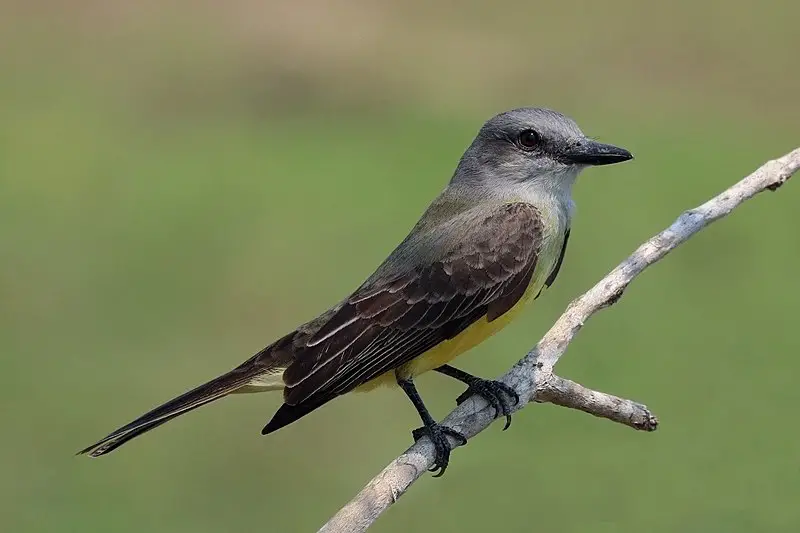
The Tropical Kingbird is an impressive bird, native to the Americas. It’s a large tyrant flycatcher that breeds in southern Arizona and Texas through Central America and down south as far as Argentina and Peru.
This species also lives on Trinidad & Tobago islands. During cold winter months, most of them migrate to warmer climates within its range.
They inhabit open areas such as fields or forests with scattered trees – but away from heavily wooded habitats.
In terms of diet, they mainly feed upon insects which are caught by hawking from perches or snatching up in flight; however it will occasionally eat fruits too.
The adult has grey-brown upperparts, darker wings edged with yellowish feathers plus a white breast band contrasting against pale orange underparts for both sexes.
A conspicuous black mask runs across their eyes completing this beautiful bird’s look.Scientific classification:
| Kingdom | Animalia |
| Phylum | Chordata |
| Class | Aves |
| Order | Passeriformes |
| Family | Tyrannidae |
| Genus | Tyrannus |
| Species | T. melancholicus |
Also Featured In: Most Common Birds In Paraguay, Most Common Birds in South America Birds
13. Masked Tityra
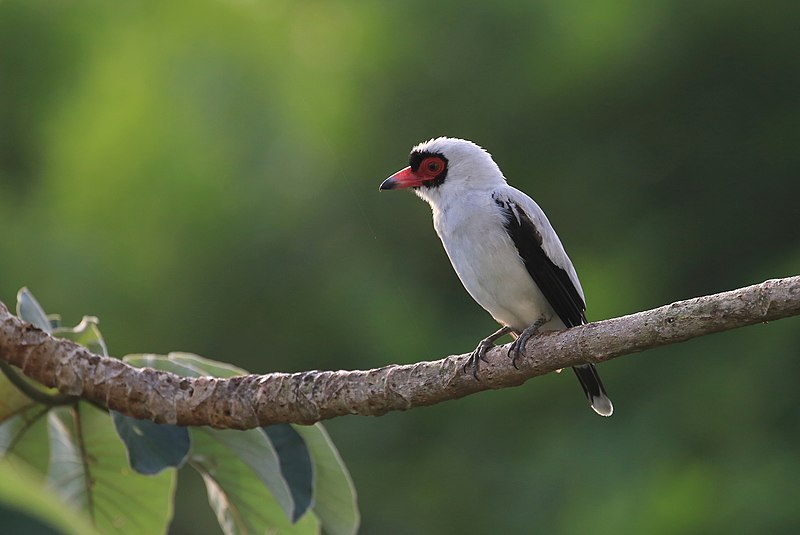
The Masked Tityra is a medium-sized passerine bird from Mexico, Central America and northern and central South America.
It has been traditionally classified as part of the cotinga or tyrant flycatcher family, however recent evidence suggests it should be better placed in its own family – Tityridae.
The masked tityra can typically be found inhabiting forests and woodlands within its range. This species appears to have adapted well to human presence since they often reside near settlements with small patches of remaining forest cover nearby.
Its striking black mask around the face combined with an overall brownish plumage make it easy to spot while perched on trees searching for food such as insects, fruits, lizards or frogs.Scientific classification:
| Kingdom | Animalia |
| Phylum | Chordata |
| Class | Aves |
| Order | Passeriformes |
| Family | Tityridae |
| Genus | Tityra |
| Species | T. semifasciata |
Also Featured In: Colorful Birds of Nicaragua,
14. Social Flycatcher
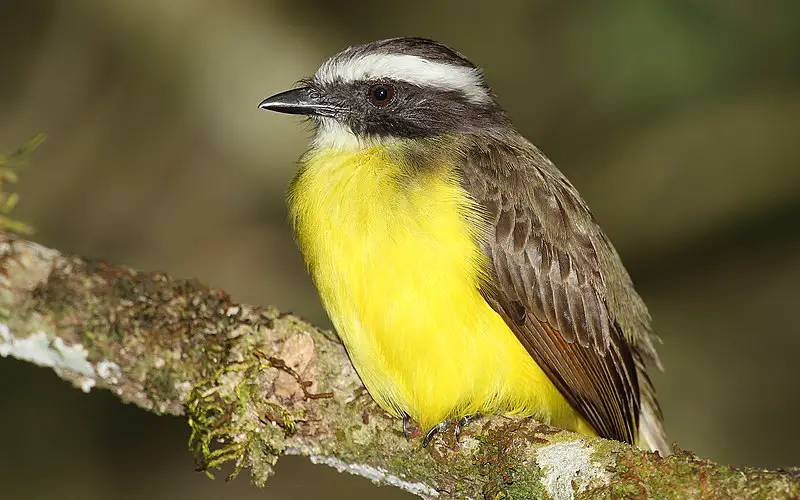
The Social Flycatcher is a medium-sized passerine bird from the Americas, belonging to the large tyrant flycatcher family.
It has often been split into two species – Myiozetetes texensis and Myiozetetes similis proper – due to its distinct range across Costa Rica northwards to Mexico and southward towards South America respectively.
This bird sports dark grey upperparts combined with white underparts, along with a vermilion crown on its head.
It also possesses an upright posture when perched which makes it easily recognizable in comparison with other birds of similar size within its habitat.
The social flycatcher feeds mainly on insects but can sometimes supplement these meals by eating fruits as well.Scientific classification:
| Kingdom | Animalia |
| Phylum | Chordata |
| Class | Aves |
| Order | Passeriformes |
| Family | Tyrannidae |
| Genus | Myiozetetes |
| Species | M. similis |
Also Featured In: Costa Rica Birds,
15. Spotted Sandpiper
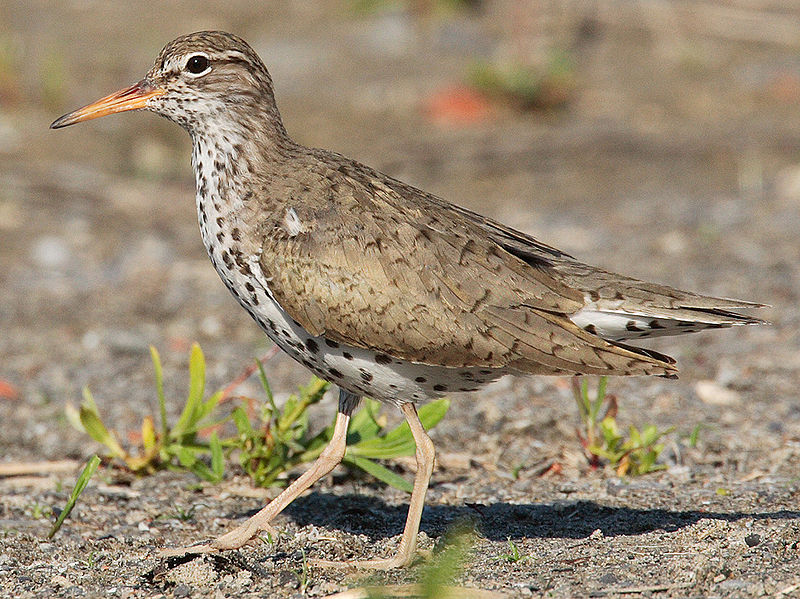
The Spotted sandpiper (Actitis macularius) is a small shorebird that can be found across North America and parts of South America.
It has an appealing spotted plumage, predominately brown in colour with white spots on the wings, tail feathers, head and neck.
The Common Sandpiper (A. hypoleucos) is its sister species which takes over geographically when the other moves away; they have been known to hybridize as well when strays settle down among breeders.
This bird was first described by Carl Linnaeus in 1766 in his twelfth edition of Systema Naturae as a migratory summer visitor to Europe but it now also occupies many habitats too like beaches, riversides and even grasslands during migration periods or for breeding season itself.
Its diet consists mainly of insects such as air-borne flies plus molluscs from shallow water areas – this makes them quite unique amongst waders.Scientific classification:
| Kingdom | Animalia |
| Phylum | Chordata |
| Class | Aves |
| Order | Charadriiformes |
| Family | Scolopacidae |
| Genus | Actitis |
| Species | A. macularius |
Also Featured In: Suriname birds, Common Central Park Birds
16. Baird’s Sandpiper
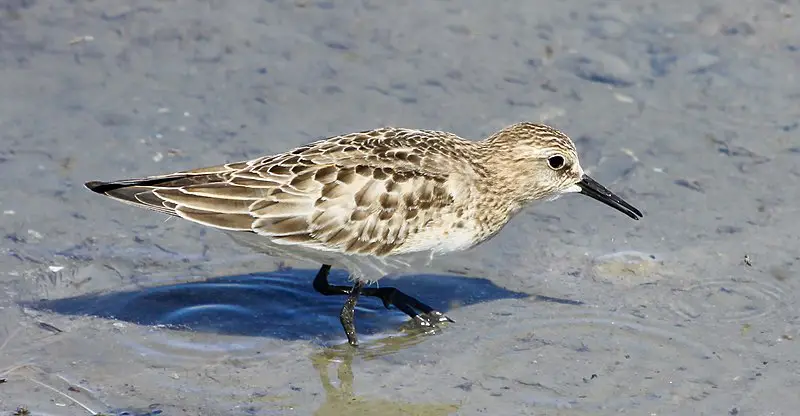
Baird’s sandpiper is a small shorebird belonging to the Calidris genus. It has grey feathers and generally inhabits waterside locations, making it highly visible in its natural environment.
This species was named after Spencer Fullerton Baird, a 19th century American ornithologist who worked with birds from across North America.
The bird is relatively widespread but may be declining in some areas due to human activity such as habitat destruction or pollution of coastal wetlands where they often reside.
As an adaptable species however, Baird’s sandpipers have been observed foraging on dry land far away from water sources during migration periods when food resources are scarce at their home grounds near waterways.Scientific classification:
| Kingdom | Animalia |
| Phylum | Chordata |
| Class | Aves |
| Order | Charadriiformes |
| Family | Scolopacidae |
| Genus | Calidris |
| Species | C. bairdii |
Also Featured In: Grenada Birds, Birds that Live in Greenland
17. Least Grebe
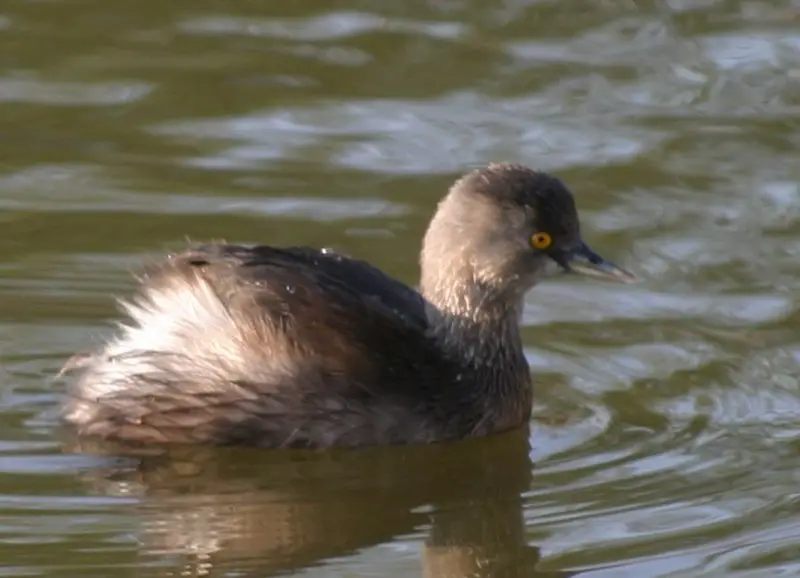
The Least Grebe is the smallest member of the grebe family and can be found in North, Central and South America. It measures around 21-27 cm long with a weight of 112-180 g.
Its range extends from southwestern United States to Argentina as well as Trinidad, Tobago, Bahamas and Greater Antilles.
The bird has an interesting plumage which varies depending on its subspecies; it may have dark brown upperparts or rusty back feathers along with whitish underparts having buff spots near the throat area.
In addition to this its neck has black streaks while head may be grey or reddish brown.
This species feeds mainly on small aquatic invertebrates like insects larvae , crustaceans etc., but also eats fish occasionally when available.
Breeding season for least grebes occurs during summer months between April -July where they build floating nests among reeds in shallow water bodiesScientific classification:
| Kingdom | Animalia |
| Phylum | Chordata |
| Class | Aves |
| Order | Podicipediformes |
| Family | Podicipedidae |
| Genus | Tachybaptus |
| Species | T. dominicus |
Also Featured In: Cayman Islands birds, Birds that Live in Tabasco
18. Bat Falcon
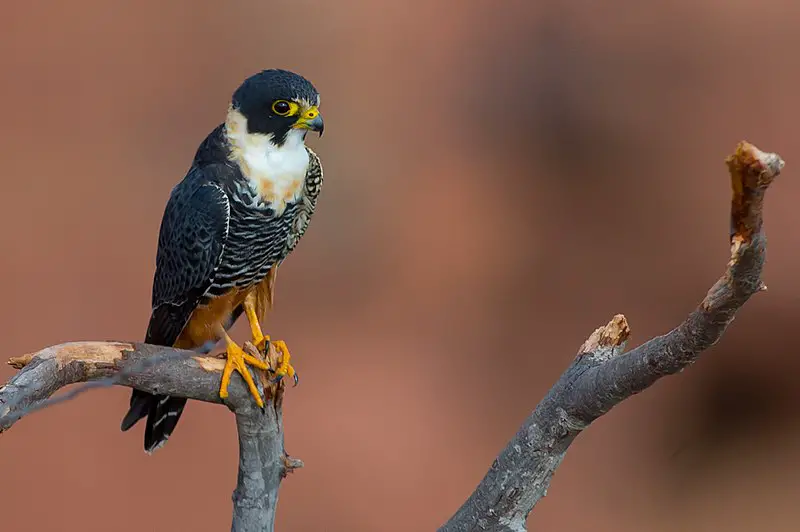
The Bat Falcon is a small falcon found in Mexico, Central and South America, as well as Trinidad. It was previously known as Falco albigularis but has since been renamed to its current name.
This bird of prey looks similar to the Orang-utan with its brownish-gray plumage and bright blue cere on top of their beaks. They are generally around 9 inches long with a wingspan reaching up to 20 inches across.
The Bat Falcons prefer open savanna or woodland habitats where they can hunt for insects or small birds during the day.
These birds rely heavily on flying insect populations which makes them vulnerable when these numbers drop due too environmental changes such climate change making it important that we protect this species from further endangerment by preserving suitable habitat types so they can continue living there happily.Scientific classification:
| Kingdom | Animalia |
| Phylum | Chordata |
| Class | Aves |
| Order | Falconiformes |
| Family | Falconidae |
| Genus | Falco |
| Species | F. rufigularis |
Also Featured In: Falcons Species, Birds You’ll Find in South Texas
19. Violet-Crowned Hummingbird
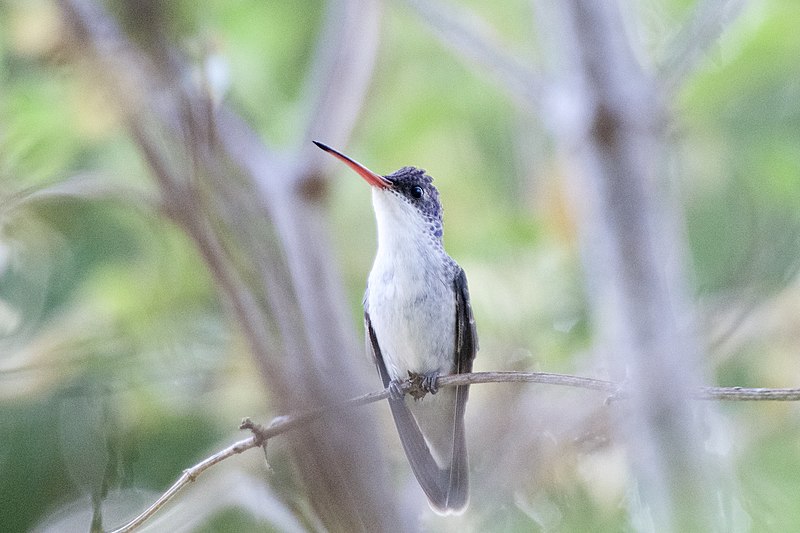
The Violet-crowned Hummingbird is a small, colorful bird found in Mexico and the southwestern United States. It belongs to the “emeralds” tribe Trochilini of subfamily Trochilinae, and was formerly placed in genus Amazilia.
The hummingbird has predominantly green plumage with white underparts, while its head features a distinctive violet crown that gives it its name.
On top of this striking coloration, males sport an iridescent gorget or throat patch which can range from purple to blue depending on lighting conditions.
These tiny birds feed mainly on nectar from flowers but also supplement their diet with insects caught mid flight for extra protein.
They are solitary creatures except during breeding season when they engage in territorial disputes over access to good food sources such as flowering trees or shrubs near water resources where there are plenty of bugs for them to catch too.Scientific classification:
| Kingdom | Animalia |
| Phylum | Chordata |
| Class | Aves |
| Order | Apodiformes |
| Family | Trochilidae |
| Genus | Ramosomyia |
| Species | R. violiceps |
Also Featured In: Hummingbirds Species, Most Common Birds in Michoacán
20. Thick-Billed Parrot
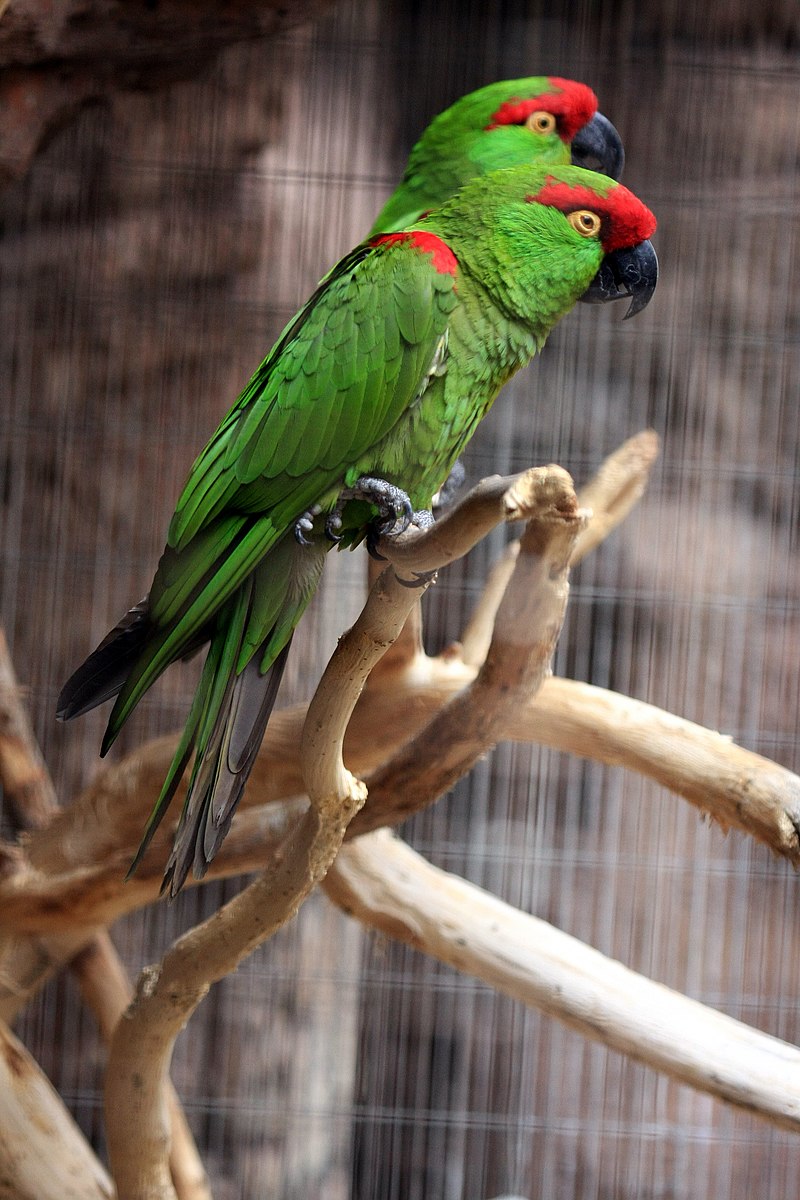
The Thick-billed parrot is a medium-sized bird native to Mexico and formerly found in the southwestern United States.
It has been classified as either its own species, or as part of another genus within the Psittacidae family.
Its feathers are made up of vibrant colors such as green on the back, with yellow edging along wings and tail, red patches around eyes and beak.
Despite being called guacamaya (“macaw”) or cotorra serrana (“mountain parrot” ) locally in Mexico due to their size, they actually aren’t related to macaws at all.
They can live for many years if well taken care of but sadly their population numbers have been dropping steadily over recent decades due to illegal trapping for pet trade purposes.Scientific classification:
| Kingdom | Animalia |
| Phylum | Chordata |
| Class | Aves |
| Order | Psittaciformes |
| Family | Psittacidae |
| Genus | Rhynchopsitta |
| Species | R. pachyrhyncha |
Also Featured In: Parrots Species,
21. Elegant Tern
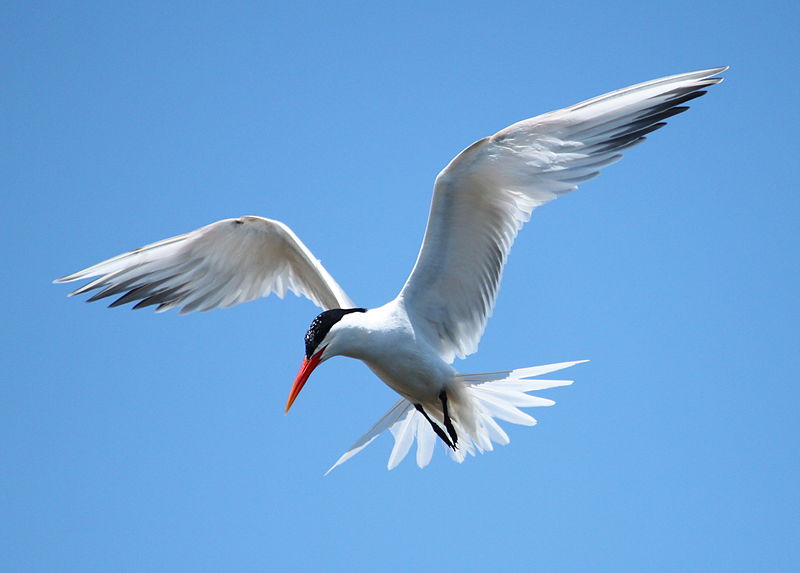
The elegant tern is a captivating species of bird found in the family Laridae. It breeds along the Pacific coasts of Southern United States and Mexico, but during winter it migrates south to Peru, Ecuador and Chile.
This species prefers nesting in dense colonies on coastal islands or exceptionally large freshwater lakes near the coast.
Isla Rasa and Montague Island are some notable examples where they can be seen breeding seasonally.
They have an impressive wingspan that ranges from 80-95 cm with a black cap extending down their neck up to half way down its chest; above which there’s white plumage throughout its body including greyish tones at certain spots thus giving them an alluring appearance.Scientific classification:
| Kingdom | Animalia |
| Phylum | Chordata |
| Class | Aves |
| Order | Charadriiformes |
| Family | Laridae |
| Genus | Thalasseus |
| Species | T. elegans |
Also Featured In: Terns Species,
22. Ladder-Backed Woodpecker
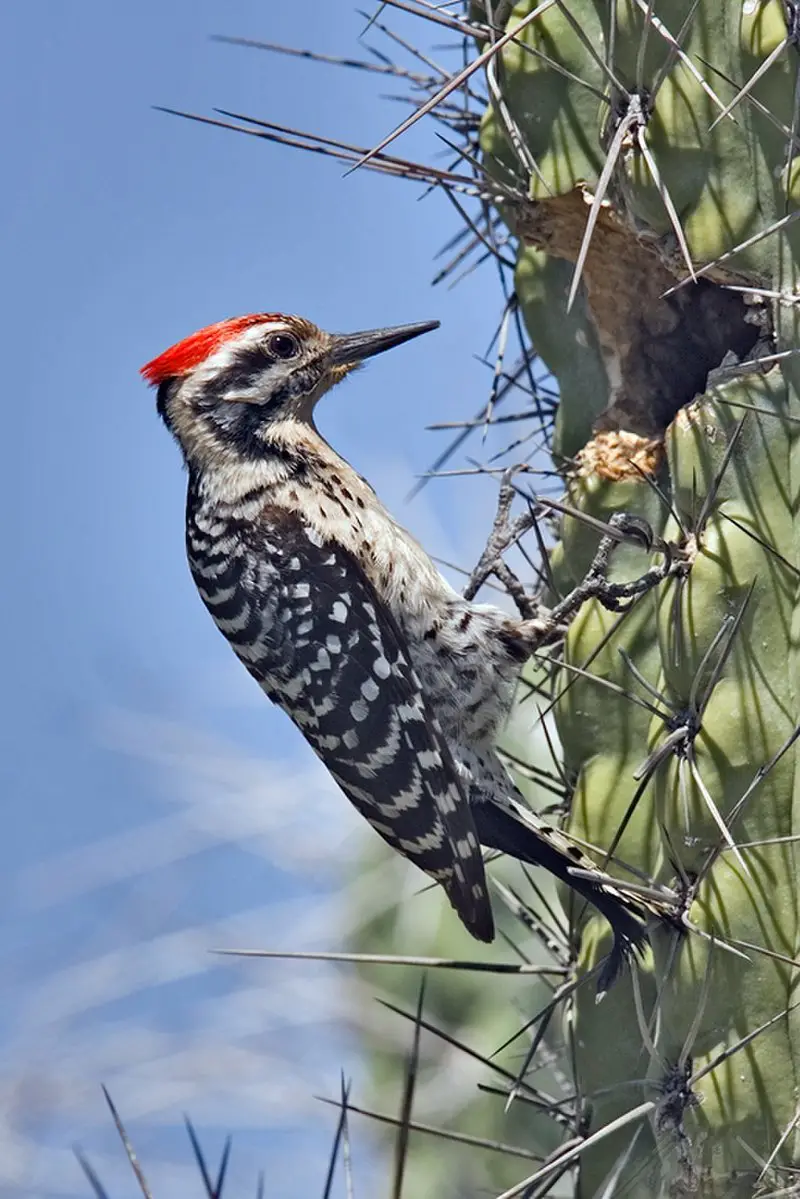
The Ladder-backed Woodpecker is a small black and white bird native to North America.
At about 16.5-19 cm in length, it has a characteristic barred pattern on its back resembling the rungs of a ladder, as well as speckled black rump and cream colored underparts on its breast and flanks.
These birds can be found inhabiting woodlands across their range, where they feed mostly on insects that they find by drilling into trees or hunting from exposed branches.
Their call consists of short chirps repeated every few seconds with an occasional longer trill thrown in for good measure.
They are also known to use twigs or other objects to probe crevices while searching for food – making them quite resourceful hunters indeed.Scientific classification:
| Kingdom | Animalia |
| Phylum | Chordata |
| Class | Aves |
| Order | Piciformes |
| Family | Picidae |
| Genus | Dryobates |
| Species | D. scalaris |
Also Featured In: Woodpeckers Species, Central Texas Birds
23. Greater Yellowlegs
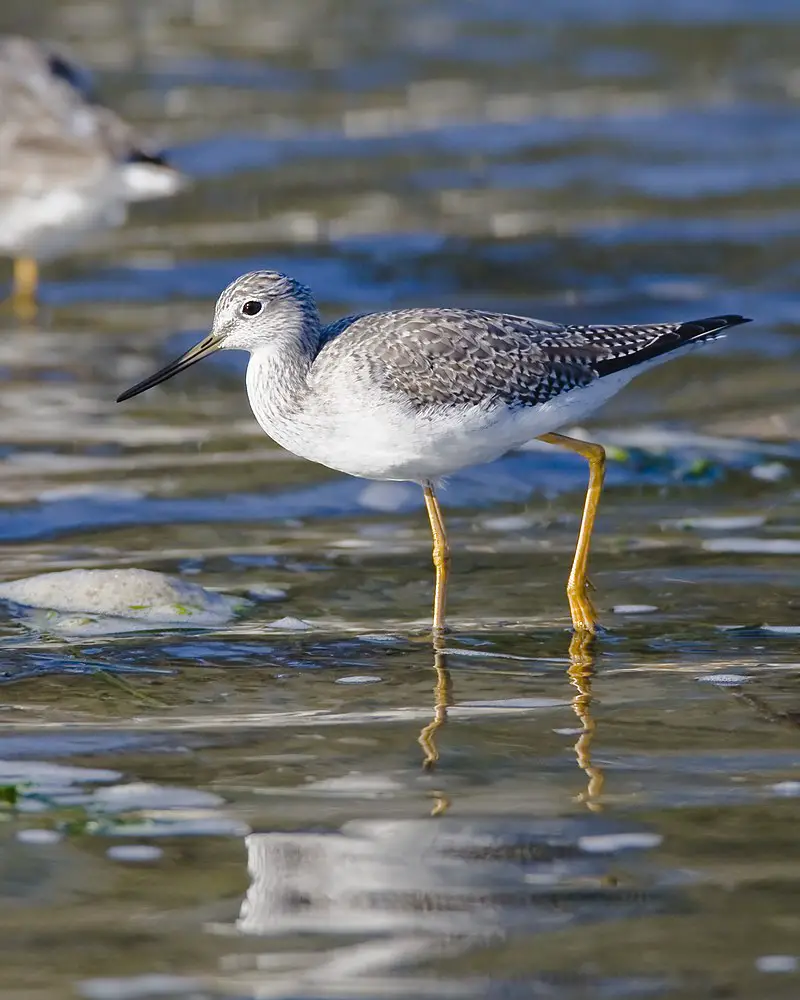
The Greater Yellowlegs is a large shorebird found in the family Scolopacidae. It nests mainly in central Canada and south Alaska, while wintering in southern North America, Central America, West Indies and South America.
The bird was formally described by German naturalist Johann Friedrich Gmelin as part of his revision to Carl Linnaeus’s Systema Naturae.
It has long yellow legs which sets it apart from other birds of its kind; when disturbed or alarmed they will flash these bright-colored limbs about wildly.
Its diet consists mostly of insects like flies, beetles, grasshoppers and dragonflies although aquatic invertebrates are also eaten on occasion.
These birds have adapted well to human habitation near shallow marshes or mudflats with plenty of food sources for them to feed upon making them an easier species for people who love bird watching.Scientific classification:
| Kingdom | Animalia |
| Phylum | Chordata |
| Class | Aves |
| Order | Charadriiformes |
| Family | Scolopacidae |
| Genus | Tringa |
| Species | T. melanoleuca |
Also Featured In: birds of Delaware, Wetlands Birds You Should Know
24. Elegant Trogon
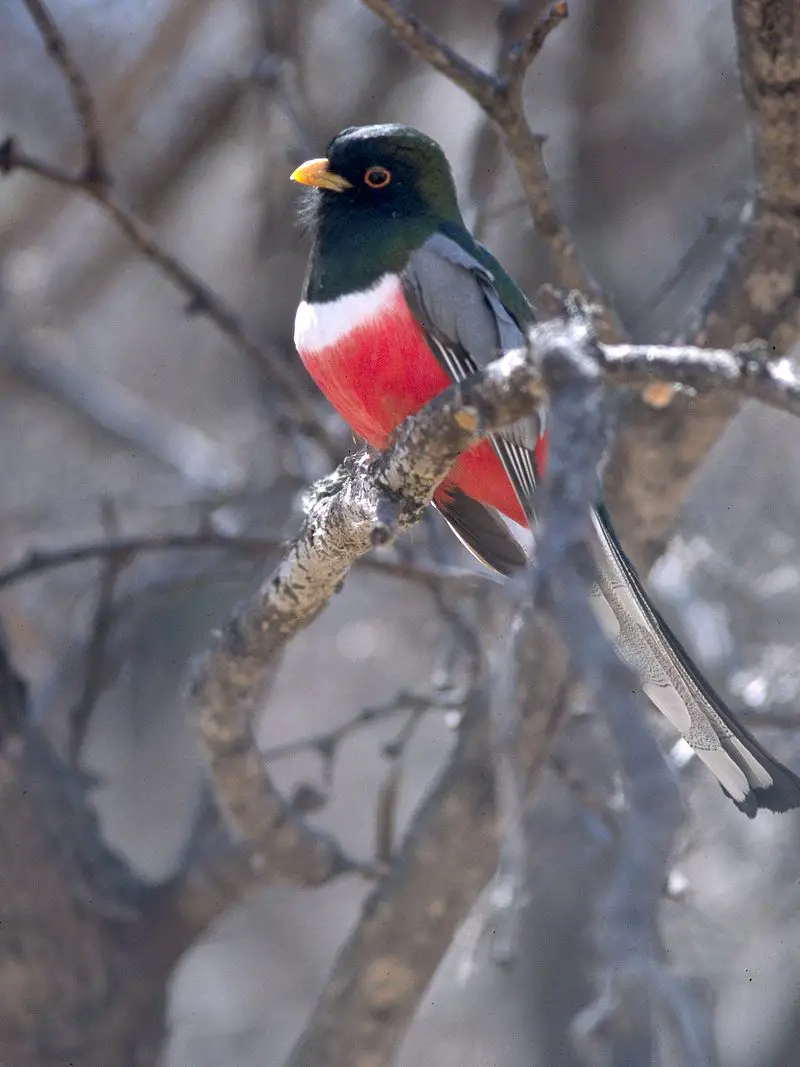
The Elegant trogon is a majestic bird of the Trogon family. It has an impressive coppery-tailed plumage, which gives it its name.
This eye-catching species can be found in Central America and parts of South America and Mexico.
Its five recognized subspecies inhabit different geographical areas with slightly varying physical features and colors on their feathers.
The most distinct among these is Trogon ambiguus, which some classify as a separate species due to its unique characteristics such as more prominent stripes on its head and back, along with duller shades of red compared to other subspecies within the same genus.
Overall this stunningly beautiful omnivore fascinates admirers all over the world for being one of nature’s best works.Scientific classification:
| Kingdom | Animalia |
| Phylum | Chordata |
| Class | Aves |
| Order | Trogoniformes |
| Family | Trogonidae |
| Genus | Trogon |
| Species | T. elegans |
Also Featured In: birds of Arizona, Red birds You’ll See in Arizona
25. Semipalmated Plover
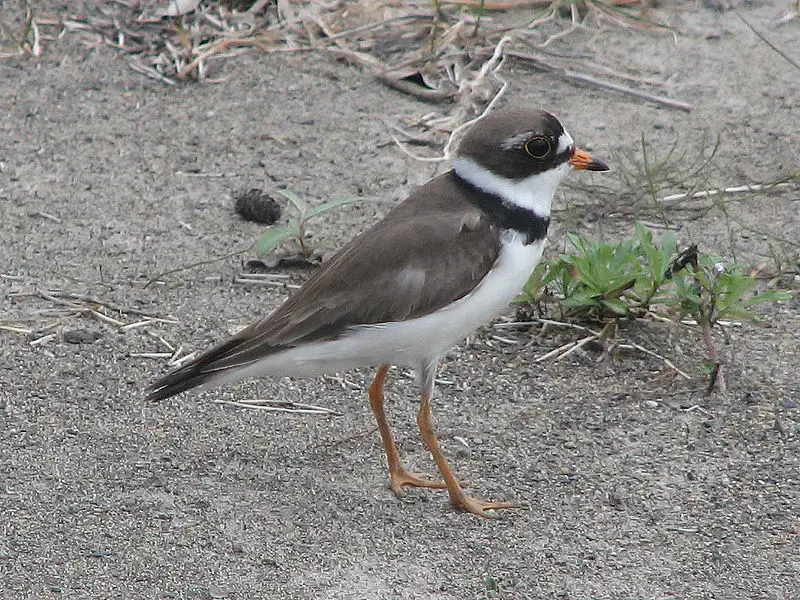
The Semipalmated plover is a small bird with yellowish coloring. Its name comes from the Latin words semi, meaning half, and palma, meaning palm, referencing the bird’s unique foot structure.
The plover is known for living in ravines and river valleys, and is a common sight along shorelines.
Despite its small size, the Semipalmated plover is known for being a strong and agile flier, able to quickly dart and twist through the air.
Its distinct coloring and fascinating behavior make it a popular subject for birdwatchers and nature enthusiasts.Scientific classification:
| Kingdom | Animalia |
| Phylum | Chordata |
| Class | Aves |
| Order | Charadriiformes |
| Family | Charadriidae |
| Genus | Charadrius |
| Species | C. semipalmatus |
Also Featured In: Galapagos Birds You Should Know, White Birds Commonly Found in Hawaii
26. Citreoline Trogon
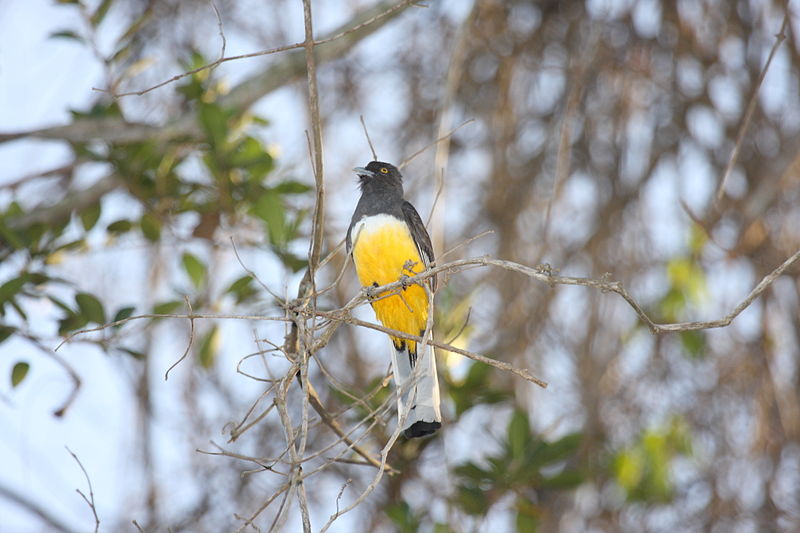
The Citreoline trogon bird is a species of bird in the Trogonidae family. It is found only in Western Mexico and has a vast estimated distribution size.
This has led to the IUCN classifying the species as least concern regarding conservation concerns, and its population trend as stable.
The bird has been studied as an ecosystem engineer, but there is not much other knowledge available about this species.Scientific classification:
| Kingdom | Animalia |
| Phylum | Chordata |
| Class | Aves |
| Order | Trogoniformes |
| Family | Trogonidae |
| Genus | Trogon |
| Species | T. citreolus |
Also Featured In: Puerto Vallarta Birds You Should Know, Common Birds of Guerrero
27. Yellow-Green Vireo
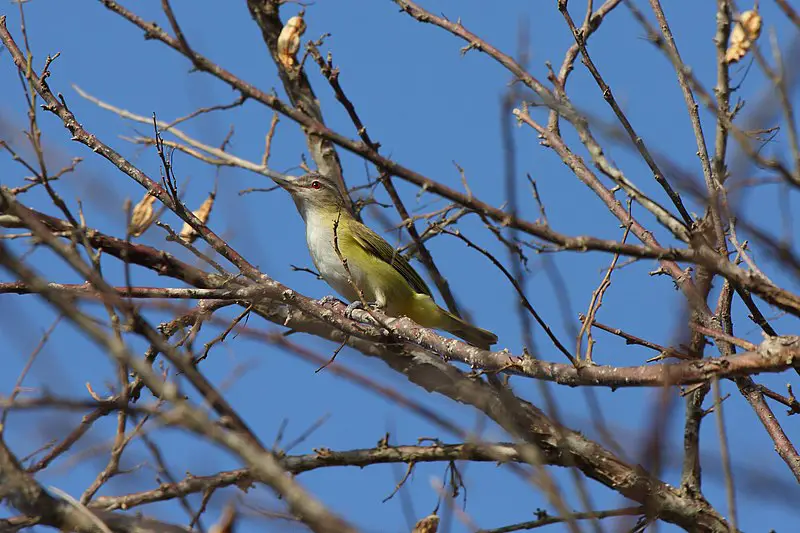
The Yellow-green vireo is a migratory passerine bird found in North and South America. It breeds in areas from Mexico to Panama and winters in the western Amazon Basin and northern and eastern Andes.
It was first described by American ornithologist John Cassin in 1851. The bird is small in size and has yellow-green plumage.
Its specific epithet, flavoviridis, is derived from the Latin words flavus (yellow) and viridis (green), which describe the bird’s coloration.
The Yellow-green vireo is known for its melodious song, and its diet mainly comprises insects and berries.
This species of vireo is a remarkable bird, and its migration patterns make it an interesting subject for bird enthusiasts to observe and study.Scientific classification:
| Kingdom | Animalia |
| Phylum | Chordata |
| Class | Aves |
| Order | Passeriformes |
| Family | Vireonidae |
| Genus | Vireo |
| Species | V. flavoviridis |
Also Featured In: Green Birds in That Live in Texas, Most Common Birds You’ll Find in Quintana Roo
28. Banded Quail
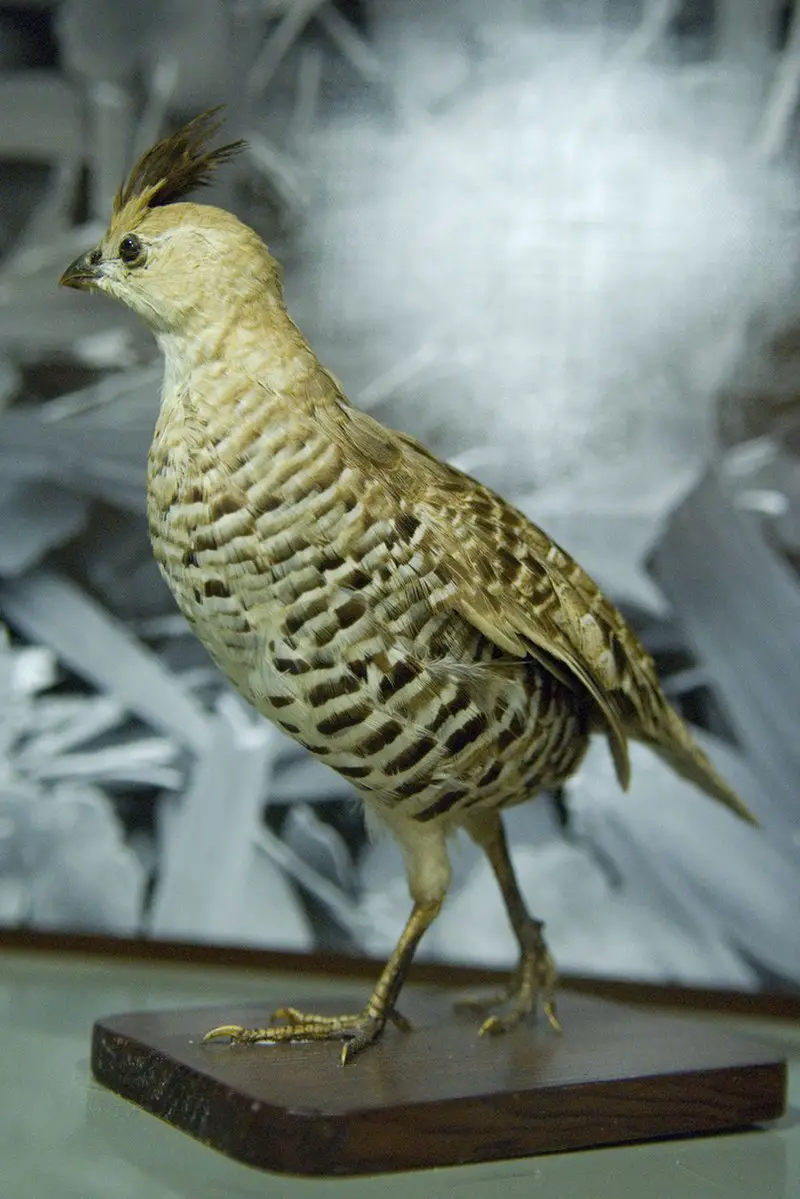
The banded quail is a brown bird found only in Mexico. It lives in subtropical or tropical dry forests, shrublands, and degraded former forests. It has a long tail and can be hard to spot.Scientific classification:
| Kingdom | Animalia |
| Phylum | Chordata |
| Class | Aves |
| Order | Galliformes |
| Family | Odontophoridae |
| Genus | Philortyx Gould, 1846 |
| Species | P. fasciatus |
29. Blue Mockingbird
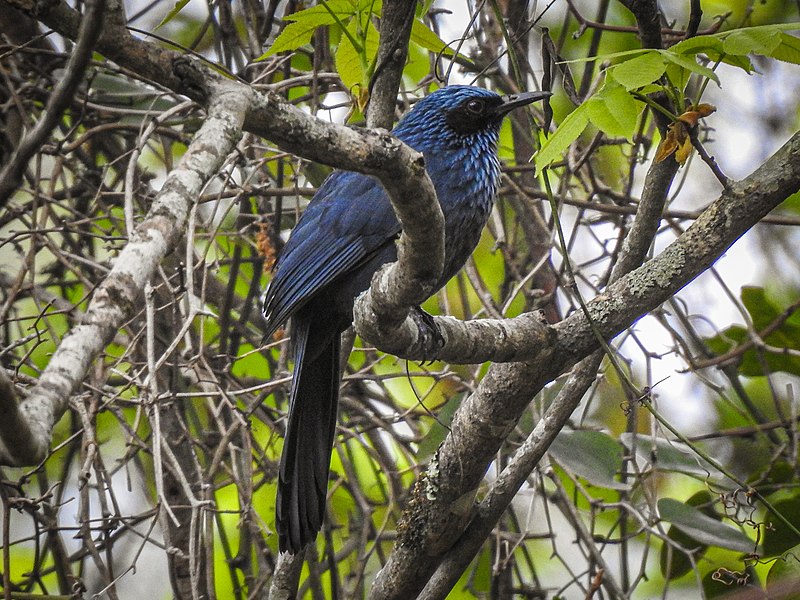
The blue mockingbird is a striking bird found only in Mexico, though rare sightings have been reported in the southern United States. Its natural habitats include dry and montane forests, as well as degraded former forest areas.
With its vibrant blue coloring, this bird is easily recognizable by its uniform blue back, tail, wings, head, and underbelly. It belongs to the family Mimidae, and is known for its impressive mimicking abilities.
Despite its beauty, this species is considered Near Threatened due to habitat loss and degradation.
The blue mockingbird serves as a reminder of the importance of conservation efforts to protect our planet’s diverse and unique wildlife.Scientific classification:
| Kingdom | Animalia |
| Phylum | Chordata |
| Class | Aves |
| Order | Passeriformes |
| Family | Mimidae |
| Genus | Melanotis |
| Species | M. caerulescens |
Also Featured In: Birds that Live in Morelos, Birds that Live around Santiago de Querétaro
30. Mexican Parrotlet
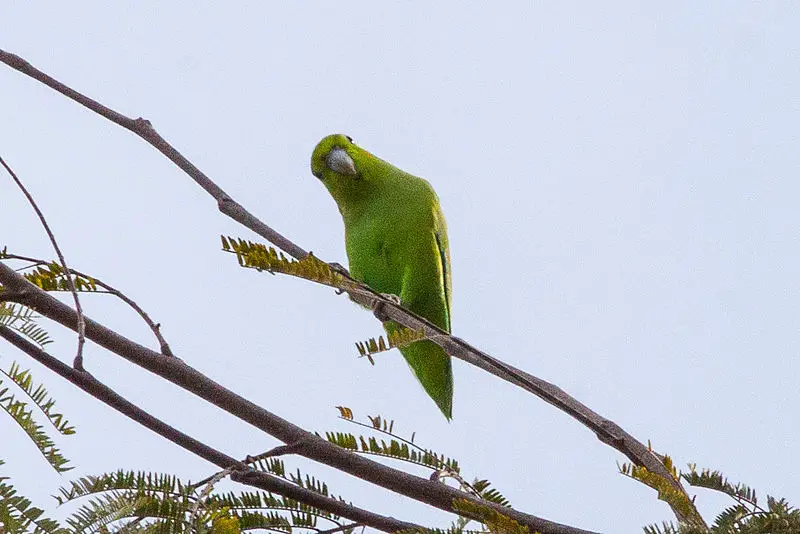
The Mexican parrotlet, also known as the turquoise-rumped parrotlet, is a species of parrot found in western Mexico.
These charming birds are prized for their beautiful turquoise-colored rumps and are a popular choice among bird enthusiasts.
The Mexican parrotlet is part of the family Psittacidae and has two subspecies: the Tres Marias parrotlet and F. c. cyanopygius.
These birds are endemic to the region and can be found from southern Sonora to Colima.
They are a joy to have as pets due to their playful and curious nature, and make wonderful additions to any aviary setting.
If one is looking for a beautiful bird with a captivating personality, the Mexican parrotlet is an excellent choice.Scientific classification:
| Kingdom | Animalia |
| Phylum | Chordata |
| Class | Aves |
| Order | Psittaciformes |
| Family | Psittacidae |
| Genus | Forpus |
| Species | F. cyanopygius |
Also Featured In: Most Common Birds Found in Nayarit,
31. Slaty Vireo
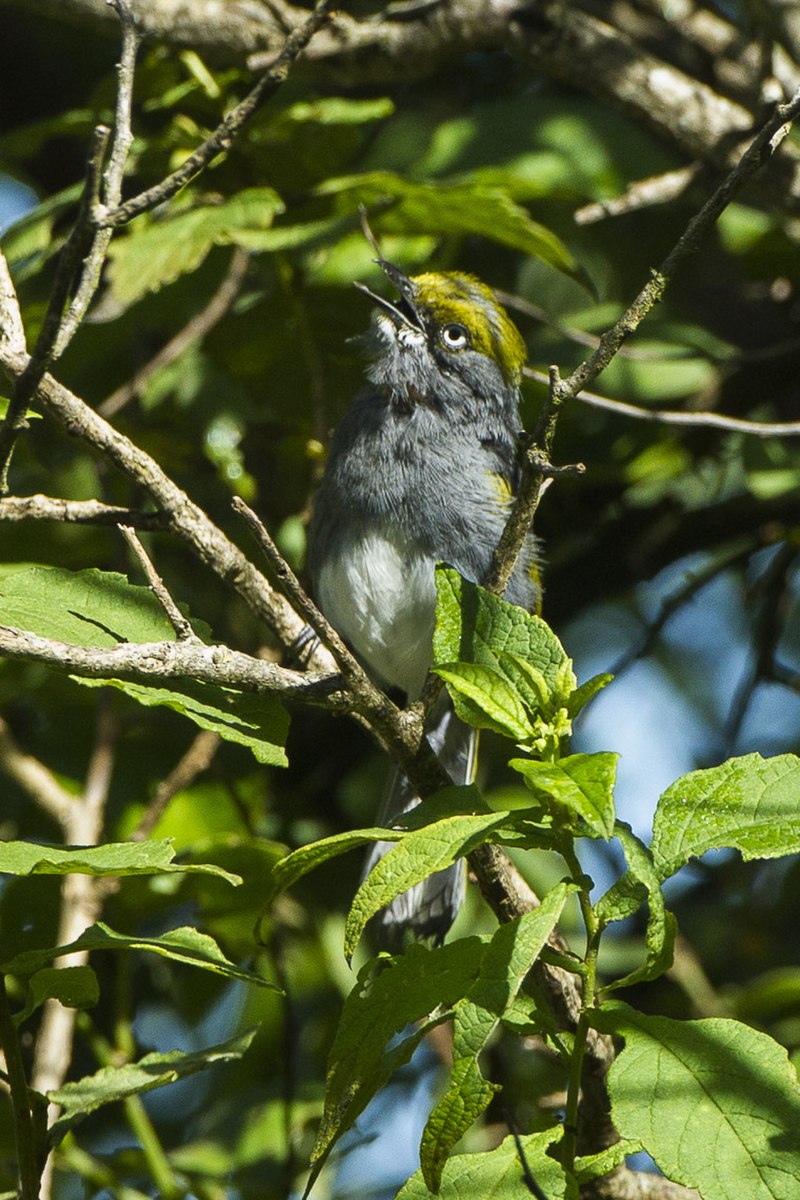
The slaty vireo is a unique bird found exclusively in the shrubby highlands of southern Mexico. Its defining feature is its predominantly slate gray plumage and a long tail, which sets it apart from other vireos.
It used to belong to a separate genus called Neochloe because of its distinct characteristics. Additionally, it has green feather edgings on its wings and tail, which contrast beautifully with its snow-white eyes, belly, and chin.
Despite being a relatively small bird, this species is captivating to watch as it moves around the dense vegetation of its habitat. Its exquisite appearance and distinct features make it a sought-after sighting among bird-watchers.
With its distinct characteristics and uniqueness, the slaty vireo serves as a valuable addition to the biodiversity of Mexico’s highlands.Scientific classification:
| Kingdom | Animalia |
| Phylum | Chordata |
| Class | Aves |
| Order | Passeriformes |
| Family | Vireonidae |
| Genus | Vireo |
| Species | V. brevipennis |